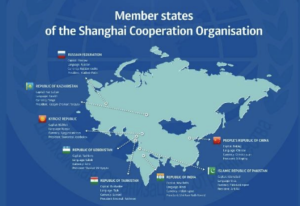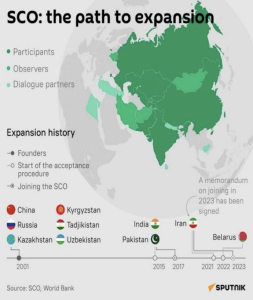1. Which of the Following Are Members of Shanghai Cooperation Organization:
- Pakistan
- India
- Turkmenistan
- Turkey
- Belarus
Which of the given above is/are Correct?
A. 1, 2 & 5 only
B. 3, 4 & 5 Only
C. 1 & 2 Only
D. All Are Members
2. With Reference to START Treaty Consider the Following
- Strategic Arms Reduction Treaty”, known as START-I, was signed between the US and the erstwhile USSR in 1991, and came into force in 1994.
- START-I, capped the numbers of nuclear warheads and intercontinental ballistic missiles (ICBMs) that each side could deploy at 6,000 and 1,600 respectively.
- START treaty lapsed in 2010 and was replaced first by the Strategic Arms Limitation Treaty (SALT) and then by the New START treaty.
Which of the Above Statements are Incorrect?
A. 1 & 2 Only
B. 2 & 3 only
C. 3 Only
D. All are Correct
3. Consider the following statements with reference to United Nations Conference on Trade and Development (UNCTAD):
- UNCTAD is a permanent body of the United Nations.
- Information Economy Report is a flagship report of UNCTAD
- The highest policy-making body of UNCTAD is the conference
Which of the statements given above is/are correct?
A. 1 and 2 only
B. 2 and 3 only
C. 1 and 3 only
D. 1, 2 and 3
4. India has “2+2” Format dialogue engagement with which of the following countries?
- Australia
- Japan
- Russia
- UAE
- Nepal
- USA
Which of the statements is/are correct?
A. 1, 3 and 4 only
B. 1, 2, 3 and 6 only
C. 1, 3, 4 and 5 only
D. 3, 5 and 6 only
5. “Rule of Law Index” is released by which of the following?
A. Amnesty International
B. International Court of Justice
C. The Office of UN Commissioner for Human Rights
D. World Justice Report
Answers with Explanation
1. Which of the Following Are Members of Shanghai Cooperation Organization:
- Pakistan
- India
- Turkmenistan
- Turkey
- Belarus
Which of the given above is/are Correct?
A. 1, 2 & 5 only
B. 3, 4 & 5 Only
C. 1 & 2 Only
D. All Are Members
Answer: C
Explanation

About SCO
- After the collapse of the Soviet Union in 1991, the then security and economic architecture in the Eurasian region dissolved and new structures had to come up.
- Russia, China, Kazakhstan, Kyrgyzstan (Kyrgyz Republic) and Tajikistan is popularly known as Shanghai Five.
- They had come together in the post-Soviet era in 1996.
- In order to work on regional security reduction of border troops, and terrorism
- Subsequently, a permanent intergovernmental international organisation called SCO was founded in June 2001.
- It is the Eurasian political, economic, and security alliance of China, Kazakhstan, Kyrgyzstan, Russia, Tajikistan, and Uzbekistan.
- Its membership was expanded to include India and Pakistan in 2017.
Members of SCO – PICK TURKEY
- P- Pakistan
- I- India
- C- China
- K- Kyrgyzstan
- T- Tajikistan
- U- Uzbekistan
- R- Russia
- K- Kazakhstan
Additional Information
- There are four Observer States interested in acceding to full membership (Afghanistan, Belarus, Iran, and Mongolia).
- There are six “Dialogue Partners” (Armenia, Azerbaijan, Cambodia, Nepal, Sri Lanka and Turkey).
- In 2021, the decision was made to start the accession process of Iran to the SCO as a full member.

2. With Reference to START Treaty Consider the Following
- Strategic Arms Reduction Treaty”, known as START-I, was signed between the US and the erstwhile USSR in 1991, and came into force in 1994.
- START-I, capped the numbers of nuclear warheads and intercontinental ballistic missiles (ICBMs) that each side could deploy at 6,000 and 1,600 respectively.
- START treaty lapsed in 2010 and was replaced first by the Strategic Arms Limitation Treaty (SALT) and then by the New START treaty.
Which of the Above Statements are Incorrect?
A. 1 & 2 Only
B. 2 & 3 only
C. 3 Only
D. All are Correct
Answer: C
Explanation
- The name START comes from the original “Strategic Arms Reduction Treaty”, known as START-I, which was signed between the US and the erstwhile USSR in 1991, and came into force in 1994.
- START-I, which capped the numbers of nuclear warheads and intercontinental ballistic missiles (ICBMs) that each side could deploy at 6,000 and 1,600 respectively.
- This lapsed in 2009 and was replaced first by the Strategic Offensive Reductions Treaty (SORT, also known as the Treaty of Moscow), and then by the New START treaty.
- The New START, officially, the “Treaty between the United States of America and the Russian Federation on Measures for the Further Reduction and Limitation of Strategic Offensive Arms”, entered into force on February 5, 2011, and placed new verifiable limits on intercontinental-range nuclear weapons.
- The two countries had to meet the treaty’s central limits on strategic offensive arms by February 5, 2018, and to then stay within those limits for the period the treaty remained in force.
- The US and Russia Federation subsequently agreed to extend the treaty through February 4, 2026.
Provisions of Treaty
- Under the Treaty, America and Russia cannot deploy more than 1,550 strategic nuclear warheads and more than 700 long-range missiles and bombers.
- It also limits each country to 800 deployed and non-deployed launchers and delivery vehicles.
- It allows each side to carry out up to 18 short-notice (32 hours) on-site inspections of strategic nuclear weapons sites annually to ensure the other has not crossed the limits of the treaty.
- Under the agreement, Russia and the U.S. exchange data twice a year on the ballistic missiles under the treaty’s purview, on bombers, test sites, nuclear bases and so on
- The treaty provides for 18 on-site inspections per year for US and Russian inspection teams.
- Type One inspections focus on sites with deployed and non-deployed strategic systems (up to 10 per year)
- Type Two inspections focus on sites with only non-deployed strategic systems (up to 8 per year)
Putin Backs out From NEW START Treaty
- Putin said the North Atlantic Treaty Organisation (NATO) and the U.S. wanted to “inflict ‘strategic defeat’ on Russia and “try to get to our nuclear facilities at the same time.”
- Mr. Putin argued that while the U.S. had pushed for the resumption of inspections of Russian nuclear facilities under the treaty NATO allies were helping Ukraine mount drone attacks on Russian air bases hosting nuclear-capable strategic bombers.
3. Consider the following statements with reference to United Nations Conference on Trade and Development (UNCTAD):
- UNCTAD is a permanent body of the United Nations.
- Information Economy Report is a flagship report of UNCTAD
- The highest policy-making body of UNCTAD is the conference
Which of the statements given above is/are correct?
A. 1 and 2 only
B. 2 and 3 only
C. 1 and 3 only
D. 1, 2 and 3
Answer: D
Explanation
Statement 1 is Correct: UNCTAD is a permanent body of the United Nations.
Statement 2 is Correct: Information Economy Report is a flagship report of UNCTAD
Statement 3 is Correct: The highest policy making body of UNCTAD is the conference.
- It was established in 1964 to promote trade, investment, and development in developing countries.
- It is a permanent organ of the United Nations (UN) General Assembly.
- It is headquartered in Geneva, Switzerland.
- UNCTAD has approximately 190 members
- The highest policy-making body of UNCTAD is the Conference, which meets once every four years to set policy guidelines and to formulate a program of work.
Functions of UNCTAD
- Achieve beneficial integration into the international trading system
- Diversify economies to make them less dependent on
- commodities
- Limit their exposure to financial volatility and debt
- Attract investment and make it more development friendly
- Increase access to Digital Technologies
Reports Published By UNCTAD
- Trade and Development Report
- World Investment Report
- The Least Developed Countries Report
- Economic Development in Africa Report
- Information Economy Report
- Technology and Innovation Report
- Review of Maritime Transport
4. India has “2+2” Format dialogue engagement with which of the following countries?
- Australia
- Japan
- Russia
- UAE
- Nepal
- USA
Which of the statements is/are correct?
A. 1, 3 and 4 only
B. 1, 2, 3 and 6 only
C. 1, 3, 4 and 5 only
D. 3, 5 and 6 only
Answer: B
Explanation
- The 2+2 dialogue is a format of meeting of the foreign and defence ministers of India and its allies on strategic and security issues.
- It helps to understand each other’s strategic concerns and sensitivities on both sides, in order to build a stronger, more integrated strategic relationship in a rapidly changing global environment.
- India has 2+2 dialogues with four key strategic partners: US, Australia, Japan, and Russia.
- The inaugural 2+2 dialogue with Australia was held in September 2021 when Jaishankar and Singh met with their counterparts Marise Payne and Peter Dutton in New Delhi.
- India held its first 2+2 dialogue with Russia in December 2021, when Russian Foreign Minister Sergey Lavrov and Defence Minister Sergei Shoigu visited India.
- The first India-Japan talks in the 2+2 format were held between Jaishankar and Singh and their Japanese counterparts Foreign Affairs Minister Motegi Toshimitsu and Minister of Defense Kono Taro on November 30, 2019, in New Delhi.
- The US is India’s oldest and most important 2+2 talks partner.
- The first 2+2 dialogue between the two countries was held during the Trump Administration.
- The then Secretary of State Michael Pompeo and then Secretary of Defence James Mattis met the late Sushma Swaraj and then Defence Minister Nirmala Sitharaman in New Delhi in September 2018.
5. “Rule of Law Index” is released by which of the following?
A. Amnesty International
B. International Court of Justice
C. The Office of UN Commissioner for Human Rights
D. World Justice Report
Answer: D
Explanation
- The World Justice Project Rule of Law Index measures how the rule of law is experienced and perceived by the general public across the globe.
- It is the world’s leading source for original, independent data on the rule of law.
- The World Justice Project (WJP) is an independent, multidisciplinary organization working create knowledge, build awareness, and stimulate action to advance the rule of law worldwide.
- Effective rule of law reduces corruption, combats poverty and disease, and protects people from injustices large and small.
- It is the foundation for communities of justice, opportunity, and peace—underpinning development, accountable government, and respect for fundamental rights.
When Laws Are Abused
- When pollution laws are ignored and inspectors are bribed, the environment suffers.
- Women fall victim to abuse when their rights are ignored and when their access to justice is limited.
- Families suffer when parents are coerced into paying bribes to get their children into health clinics and even schools.
- Local and international businesses avoid investing in communities where there is a lack of stable rules and regulations, leading to excessive amounts of risk.
GOALS
The World Justice Project has three primary goals:
- Increased understanding of the rule of law and its foundational importance.
- Greater rule of law adherence by governments.
- Multidisciplinary, home-grown cultures of the rule of law.
Rule of Law Means
- Rule of law means better public health, economic development, and political participation.
- It is the necessary ingredient to all forms of human endeavor, especially in communities of greatest need.
➡️UPSC 2023 General Studies Course: https://sleepyclasses.com/general-studies-for-upsc/
➡️Sociology Optional for UPSC : https://sleepyclasses.com/sociology-for-upsc/
➡️Political Science and IR for UPSC: https://sleepyclasses.com/psir-for-upsc/
➡️Signup here – https://sleepyclasses.com/
Have any query related to UPSC preparation: 📞Contact Us ► Toll-Free: 1800 890 3043 ► Mobile: 6280133177 ► Email: Sleepy.Classes@gmail.com ► WhatsApp: 6280133177



